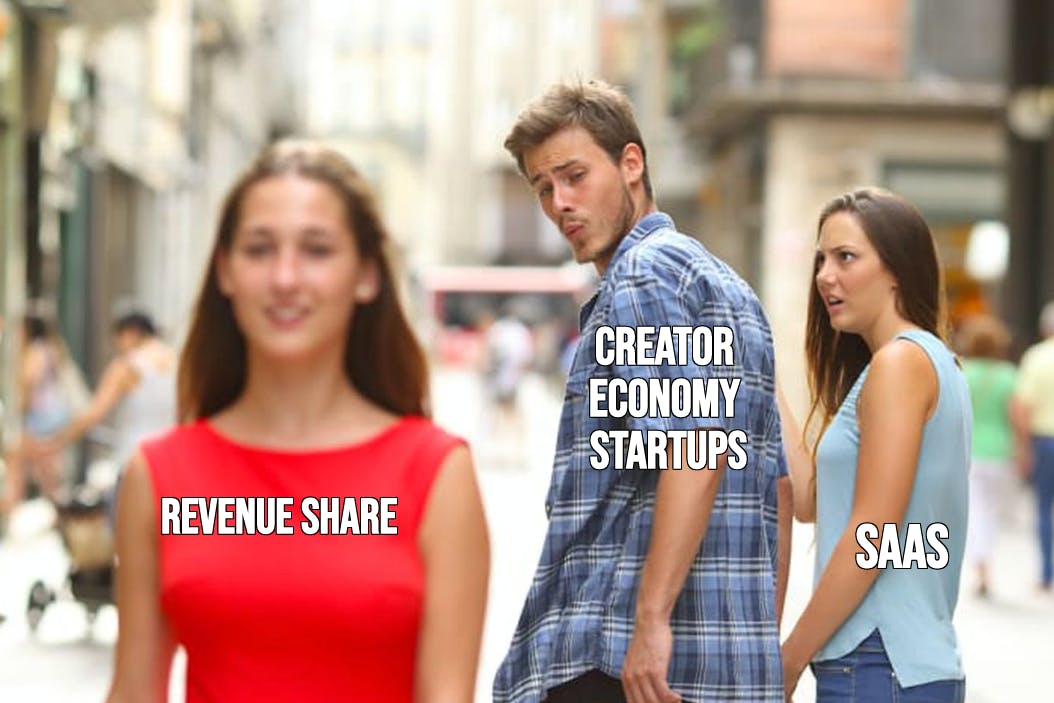Subscribe
Sign in
How startups can survive the creator economy winter

Share On
The race for revenue share
Evan Armstrong is an investor, founder, and adviser. He's a lead writer at Every, where he writes the Napkin Math, a publication focused on business breakdowns, by the numbers. Find him on Twitter: @itsearmstrong.
TL;DR Because 99% of creator revenue accumulates at the top .01% of creators, creator economy startups have to find a way to justify taking a % of revenue. This is not an easy task and only a select few will succeed in the coming bear market.
From 2020-2022, it was relatively easy to raise a seed round for your startup. All you had to do was cryptically tweet out the password, “I’m building something new in the creator economy,” and $5M would magically appear in your bank account. Even the A round would generally be that easy with crossover funds vomiting capital everywhere.
That was then, this is now. Interest rates are up! Digital monkeys now only sell for 100K instead of the millions they are worth! Founders are looking at 20x revenue multiples and shaking, crying, throwing up. Venture capitalists are learning what the phrase “cash flow” means. It’s terrible out there! I’m being more than a smidge facetious, but in all seriousness: private market capital is going to be in short supply for sometime.
My friends, a creator economy winter is coming. The result will be a thinning of the creator economy herd. In the short run, many of the buzzier startups will fold. In the long-term, the gritty teams will pull through this period with superlative companies serving this emerging class of digital entrepreneurs. The difference between the two will come down to how well these startups are able to answer one question: what are you doing to earn revenue share?
In researching this piece, I’ve talked with dozens of management teams, over a hundred creators, and the most prominent investors in the creator space. Thanks to all those who were so generous with their time..
Now, to business: to understand why revenue share is so important, we must go in depth of what creators are like as customers.
This is an excerpt from a post originally published on Every.to.
Comments (3)
Ihtesham Haider@ihteshamit

The Prohuman AI
Yes that's the truth. The fall is coming.
Share
In the past decade, we’ve seen a boom in the creator economy. With the rise of platforms like YouTube, Instagram, and Snapchat, anyone with a phone and an idea can become a content creator and build an audience. But as we enter into 2020, it’s becoming clear that the honeymoon phase of the creator economy is coming to an end.
what does iso mean in basketball
As big tech companies tighten their grip on the market and new platforms fail to gain traction, many creators are struggling to make a living. In order to survive this winter, startups need to focus on three things: diversifying their revenue streams, building strong relationships with their audience, and creating quality content.
Diversifying Revenue Streams:
The key to surviving the winter is diversifying your revenue streams.
In the volatile landscape of the creator economy, startups face a daunting challenge to endure the inevitable winters. Diversification, agility, and strategic partnerships become paramount. However, navigating these turbulent waters requires more than just survival instincts. It demands a keen eye for market trends and innovative solutions. Tools like Meyka, a stock trading analysis generator https://meyka.com/, offer invaluable insights, empowering startups to make informed decisions and thrive even in the harshest climates.
More stories

Mathew Hardy · How To · 3 min read
How to Detect AI Content with Keystroke Tracking

Sanjana Friedman · Opinions · 9 min read
The Case for Supabase

Vaibhav Gupta · Opinions · 10 min read
3.5 Years, 12 Hard Pivots, Still Not Dead
Kyle Corbitt · How To · 5 min read
A Founder’s Guide to AI Fine-Tuning

Chris Bakke · How To · 6 min read
A Better Way to Get Your First 10 B2B Customers
